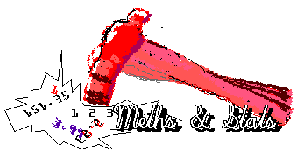
|
Research manifesto
CERG Resources
|
A topic which can create a great deal of confusion in social and educational research is that of types of scales used in measuring behaviour. It is critical because it relates to the types of statistics you can use to analyse your data. An easy way to have a paper rejected is to have used either an incorrect scale/statistic combination or to have used a low powered statistic on a high powered set of data.
A nominal scale, as the name implies, is simply some placing of data into categories, without any order or structure. A physical example of a nominal scale is the terms we use for colours. The underlying spectrum is ordered but the names are nominal. In research activities a YES/NO scale is nominal. It has no order and there is no distance between YES and NO.
The statistics which can be used with nominal scales are in the non-parametric group. The most likely ones would be:
crosstabulation - with chi-square
The simplest ordinal scale is a ranking. When a market researcher asks you to rank 5 types of beer from most flavourful to least flavourful, he/she is asking you to create an ordinal scale of preference. There is no objective distance between any two points on your subjective scale. For you the top beer may be far superior to the second prefered beer but, to another respondant with the same top and second beer, the distance may be subjectively small. An ordinal scale only lets you interpret gross order and not the relative positional distances.
Ordinal data would use non-parametric statistics. These would include:
rank order correlation non-parametric analysis of variance
When you are asked to rate your satisfaction with a piece of software on a 7 point scale, from Dissatisfied to Satisfied, you are using an interval scale. It is an interval scale because it is assumed to have equidistant points between each of the scale elements. This means that we can interpret differences in the distance along the scale. We contrast this to an ordinal scale where we can only talk about differences in order, not differences in the degree of order. Interval scales are also scales which are defined by metrics such as logarithms. In these cases, the distances are note equal but they are strictly definable based on the metric used.
Interval scale data would use parametric statistical techniques:
Correlation - r Regression Analysis of variance Factor analysis
Remember that you can use non-parametric techniques with interval and ratio data. But non-paramteric techniques are less powerful than the parametric ones.
The factor which clearly defines a ratio scale is that it has a true zero point. The simplest example of a ratio scale is the measurement of length (disregarding any philosophical points about defining how we can identify zero length). The best way to contrast interval and ratio scales is to look at temperature. The Centigrade scale has a zero point but it is an arbitrary one. The Farenheit scale has its equivalent point at -32o. (Physicists would probably argue that Absolute Zero is the zero point for temperature but this is a theoretical concept.) So, even though temperture looks as if it would be a ratio scale it is an interval scale. Currently, we cannot talk about no temperature - and this would be needed if it were a ration scale.
The same as for Interval data
|